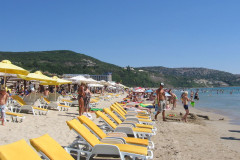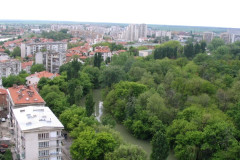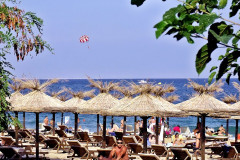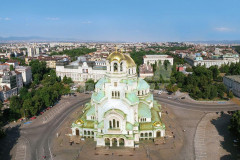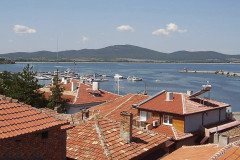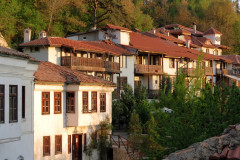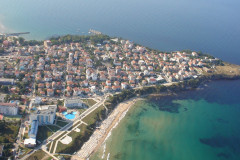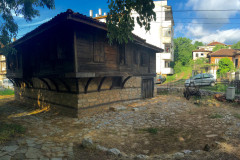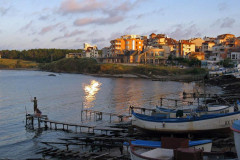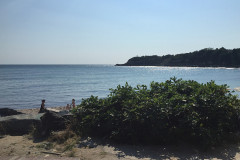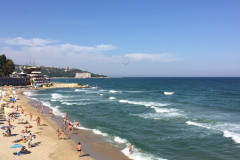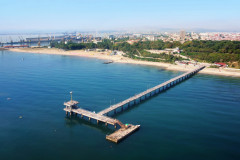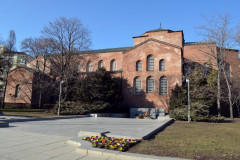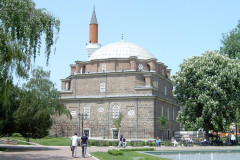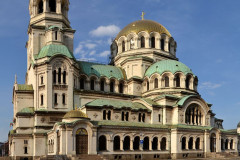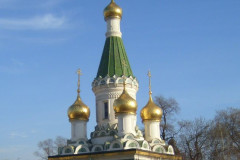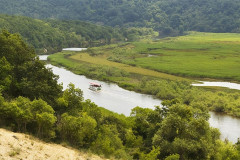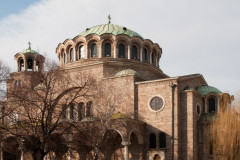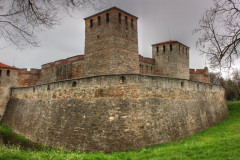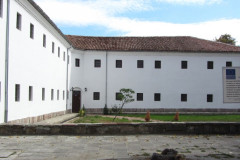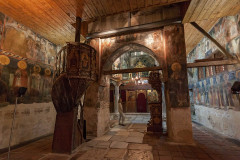Bulgaria
Hotels
Regions (27)
Towns (15)
Places
Description
Bulgaria is a country in southeastern Europe. It is bordered by Romania to the north, Serbia and Macedonia to the west, Greece and Turkey to the south, and the Black Sea to the east. With a territory of 110,994 square kilometres (42,855 sq mi), Bulgaria is Europe's 16th-largest country.
Organised prehistoric cultures began developing on Bulgarian lands during the Neolithic period. Its ancient history saw the presence of the Thracians, Greeks and Romans. The emergence of a unified Bulgarian state dates back to the establishment of the First Bulgarian Empire in 681 AD, which dominated most of the Balkans and functioned as a cultural hub for Slavs during the Middle Ages. With the downfall of the Second Bulgarian Empire in 1396, its territories came under Ottoman rule for nearly five centuries. The Russo-Turkish War (1877–78) led to the formation of the Third Bulgarian State. The following years saw several conflicts with its neighbours, which prompted Bulgaria to align with Germany in both world wars. In 1946 it became a one-party socialist state as part of the Soviet-led Eastern Bloc. In December 1989 the ruling Communist Party allowed multi-party elections, which subsequently led to Bulgaria's transition into a democracy and a market-based economy.
Bulgaria's population of 7.4 million people is predominantly urbanised and mainly concentrated in the administrative centres of its 28 provinces. Most commercial and cultural activities are centred on the capital and largest city, Sofia. The strongest sectors of the economy are heavy industry, power engineering, and agriculture, all of which rely on local natural resources.
The country's current political structure dates to the adoption of a democratic constitution in 1991. Bulgaria is a unitary parliamentary republic with a high degree of political, administrative, and economic centralisation. It is a member of the European Union, NATO, and the Council of Europe; a founding state of the Organization for Security and Co-operation in Europe (OSCE); and has taken a seat at the UN Security Council three times.
History
Prehistory and antiquity
Human activity in the lands of modern Bulgaria can be traced back to the Paleolithic. Animal bones incised with man-made markings from Kozarnika cave are assumed to be the earliest examples of symbolic behaviour in humans. Organised prehistoric societies in Bulgarian lands include the Neolithic Hamangia culture, Vinča culture and the eneolithic Varna culture (fifth millennium BC). The latter is credited with inventing gold working and exploitation. Some of these first gold smelters produced the coins, weapons and jewellery of the Varna Necropolis treasure, the oldest in the world with an approximate age of over 6,000 years. This site also offers insights for understanding the social hierarchy of the earliest European societies.
Thracians, one of the three primary ancestral groups of modern Bulgarians, began appearing in the region during the Iron Age. In the late 6th century BC, the Persians conquered most of present-day Bulgaria. and kept it until 479 BC. With influence from the Persians, the bulk of the Thracian tribes were united in the Odrysian kingdom in the 470s BC by king Teres, but were later subjugated by Alexander the Great and by the Romans in 46 AD. After the division of the Roman Empire in 5th century the area fell under Byzantine control. By this time, Christianity had already spread in the region. A small Gothic community in Nicopolis ad Istrum produced the first Germanic language book in the 4th century, the Wulfila Bible. The first Christian monastery in Europe was established around the same time by Saint Athanasius in central Bulgaria. From the 6th century the easternmost South Slavs gradually settled in the region, assimilating the Hellenised or Romanised Thracians.
First Bulgarian Empire
In 680 Bulgar tribes, under the leadership of Asparukh moved south across the Danube and settled in the area between the lower Danube and the Balkan, establishing their capital at Pliska. A peace treaty with Byzantium in 681 marked the beginning of the First Bulgarian Empire. The Bulgars gradually mixed up with the local population, adopting a common language on the basis of the local Slavic dialect.
Succeeding rulers strengthened the Bulgarian state throughout the 8th and 9th centuries. Krum doubled the country's territory, killed Byzantine emperor Nicephorus I in the Battle of Pliska, and introduced the first written code of law. Paganism was abolished in favour of Eastern Orthodox Christianity under Boris I in 864. This conversion was followed by a Byzantine recognition of the Bulgarian church and the adoption of the Cyrillic alphabet developed at Preslav which strengthened central authority and helped fuse the Slavs and Bulgars into a unified people. A subsequent cultural golden age began during the 34-year rule of Simeon the Great, who also achieved the largest territorial expansion of the state.
Wars with Magyars and Pechenegs and the spread of the Bogomil heresy weakened Bulgaria after Simeon's death. Consecutive Rus' and Byzantine invasions resulted in the seizure of the capital Preslav by the Byzantine army in 971. Under Samuil, Bulgaria briefly recovered from these attacks, but this rise ended when Byzantine emperor Basil II defeated the Bulgarian army at Klyuch in 1014. Samuil died shortly after the battle, and by 1018 the Byzantines had ended the First Bulgarian Empire.
Second Bulgarian Empire
After his conquest of Bulgaria, Basil II prevented revolts and discontent by retaining the rule of the local nobility and by relieving the newly conquered lands of the obligation to pay taxes in gold, allowing them to be paid in kind instead. He also allowed the Bulgarian Patriarchate to retain its autocephalous status and all its dioceses, but reduced it to an archbishopric. After his death Byzantine domestic policies changed and a series of unsuccessful rebellions broke out, the largest being led by Peter Delyan. In 1185 Asen dynasty nobles Ivan Asen I and Peter IV organised a major uprising which resulted in the re-establishment of the Bulgarian state. Ivan Asen and Peter laid the foundations of the Second Bulgarian Empire with Tarnovo as a capital.
Kaloyan, the third of the Asen monarchs, extended his dominion to Belgrade and Ohrid. He acknowledged the spiritual supremacy of the Pope and received a royal crown from a papal legate. The empire reached its zenith under Ivan Asen II (1218–1241), when commerce and culture flourished. The strong economic and religious influence of Tarnovo made it a "Third Rome", unlike the already declining Constantinople.
The country's military and economic might declined after the Asen dynasty ended in 1257, facing internal conflicts, constant Byzantine and Hungarian attacks and Mongol domination. By the end of the 14th century, factional divisions between the feudal landlords and the spread of Bogomilism had caused the Second Bulgarian Empire to split into three tsardoms—Vidin, Tarnovo and Karvuna—and several semi-independent principalities that fought each other, along with Byzantines, Hungarians, Serbs, Venetians and Genoese. By the late 14th century the Ottoman Turks had started their conquest of Bulgaria and had taken most towns and fortresses south of the Balkan mountains.
Ottoman rule
Tarnovo was captured by the Ottomans after a three-month siege in 1393. After the Battle of Nicopolis in 1396 brought about the fall of the Vidin Tsardom, the Ottomans conquered all Bulgarian lands south of the Danube. The nobility was eliminated and the peasantry was enserfed to Ottoman masters, with much of the educated clergy fleeing to other countries. Under the Ottoman system, Christians were considered an inferior class of people. Thus, Bulgarians, like other Christians, were subjected to heavy taxes and a small portion of the Bulgarian populace experienced partial or complete Islamisation, and their culture was suppressed. Ottoman authorities established the Rum Millet, a religious administrative community which governed all Orthodox Christians regardless of their ethnicity. Most of the local population gradually lost its distinct national consciousness, identifying as Christians. However, the clergy remaining in some isolated monasteries kept it alive, and that helped it to survive as in some rural, remote areas, as well as in the militant Catholic community in the northwestern part of the country.
Several Bulgarian revolts erupted throughout the nearly five centuries of Ottoman rule, most notably the Habsburg-backed Tarnovo uprisings in 1598 and in 1686, the Chiprovtsi Uprising in 1688 and Karposh's Rebellion in 1689. In the 18th century, the Enlightenment in Western Europe provided influence for the initiation of a movement known as the National awakening of Bulgaria. It restored national consciousness and became a key factor in the liberation struggle, resulting in the 1876 April Uprising. Up to 30,000 Bulgarians were killed as Ottoman authorities put down the rebellion. The massacres prompted the Great Powers to take action. They convened the Constantinople Conference in 1876, but their decisions were rejected by the Ottomans. This allowed the Russian Empire to seek a solution by force without risking military confrontation with other Great Powers, as had happened in the Crimean War. In 1877 Russia declared war on the Ottoman Empire and defeated its forces with the help of Bulgarian volunteers.
Third Bulgarian state
The Treaty of San Stefano was signed on 3 March 1878 by Russia and the Ottoman Empire, and included a provision to set up an autonomous Bulgarian principality roughly on the territories of the Second Bulgarian Empire. The other Great Powers immediately rejected the treaty out of fear that such a large country in the Balkans might threaten their interests. It was superseded by the subsequent Treaty of Berlin, signed on 13 July, provided for a much smaller state comprising Moesia and the region of Sofia, leaving large populations of Bulgarians outside the new country. This played a significant role in forming Bulgaria's militaristic approach to foreign affairs during the first half of the 20th century.
The Bulgarian principality won a war against Serbia and incorporated the semi-autonomous Ottoman territory of Eastern Rumelia in 1885, proclaiming itself an independent state on 5 October 1908. In the years following independence, Bulgaria increasingly militarised and was often referred to as "the Balkan Prussia".
Between 1912 and 1918, Bulgaria became involved in three consecutive conflicts—two Balkan Wars and World War I. After a disastrous defeat in the Second Balkan War, Bulgaria again found itself fighting on the losing side as a result of its alliance with the Central Powers in World War I. Despite fielding more than a quarter of its population in a 1,200,000-strong army and achieving several decisive victories at Doiran and Dobrich, the country capitulated in 1918. The war resulted in significant territorial losses, and a total of 87,500 soldiers killed. More than 253,000 refugees immigrated to Bulgaria from 1912 to 1929 due to the effects of these wars, placing additional strain on the already ruined national economy.
The political unrest resulting from these losses led to the establishment of a royal authoritarian dictatorship by tsar Boris III (1918–1943). Bulgaria entered World War II in 1941 as a member of the Axis but declined to participate in Operation Barbarossa and saved its Jewish population from deportation to concentration camps. The sudden death of Boris III in the summer of 1943 pushed the country into political turmoil as the war turned against Germany and the Communist guerrilla movement gained momentum. The government of Bogdan Filov subsequently failed to achieve peace with the Allies. Bulgaria did not comply with Soviet demands to expel German forces from its territory, resulting in a declaration of war and an invasion by the USSR in September 1944. The Communist-dominated Fatherland Front took power, ended participation in the Axis and joined the Allied side until the war ended.
World War I: Bulgarian soldiers cutting barbed wire laid by the Entente Powers and preparing to advance.
The left-wing uprising of 9 September 1944 led to the abolition of monarchic rule, but it was not until 1946 that a one-party people's republic was established. It became a part of the Soviet sphere of influence under the leadership of Georgi Dimitrov (1946–1949), who laid the foundations for a rapidly industrialising stalinist state which was also highly repressive with thousands of dissidents executed. By the mid-1950s standards of living rose significantly, while political repressions were lessened. By the 1980s both national and per capita GDP quadrupled, but the economy remained prone to debt spikes, the most severe taking place in 1960, 1977 and 1980. The Soviet-style planned economy saw some market-oriented policies emerging on an experimental level under Todor Zhivkov (1954–1989). His daughter Lyudmila bolstered national pride by promoting Bulgarian heritage, culture and arts worldwide. In an attempt to erase the identity of the ethnic Turk minority, an assimilation campaign was launched in 1984 which included closing mosques and forcing ethnic Turks to adopt Slavic names. These policies (combined with the end of communist rule in 1989) resulted in the emigration of some 300,000 ethnic Turks to Turkey.
Under the influence of the collapsing of the Eastern Bloc, on 10 November 1989 the Communist Party gave up its political monopoly, Zhivkov resigned, and Bulgaria embarked on a transition to a parliamentary democracy. The first free elections in June 1990 were won by the Bulgarian Socialist Party (BSP, the freshly renamed Communist Party). A new constitution that provided for a relatively weak elected President and for a Prime Minister accountable to the legislature was adopted in July 1991. The new system initially failed to improve living standards or create economic growth—the average quality of life and economic performance remained lower than under Communism well into the early 2000s. A 1997 reform package restored economic growth, but living standards continued to suffer. After 2001 economic, political and geopolitical conditions improved greatly, and Bulgaria achieved high Human Development status. It became a member of NATO in 2004 and participated in the War in Afghanistan. After several years of reforms it joined the European Union in 2007 despite continued concerns about government corruption.
Geography
Bulgaria occupies a portion of the eastern Balkan peninsula, bordering five countries—Greece and Turkey to the south, Macedonia and Serbia to the west, and Romania to the north. The land borders have a total length of 1,808 kilometres (1,123 mi), and the coastline has a length of 354 kilometres (220 mi). Its total area of 110,994 square kilometres (42,855 sq mi) ranks it as the world's 105th-largest country. Bulgaria's geographic coordinates are 43° N 25° E.
The most notable topographical features are the Danubian Plain, the Balkan Mountains, the Thracian Plain, and the Rhodope Mountains. The southern edge of the Danubian Plain slopes upward into the foothills of the Balkans, while the Danube defines the border with Romania. The Thracian Plain is roughly triangular, beginning southeast of Sofia and broadening as it reaches the Black Sea coast.
The Balkan mountains run laterally through the middle of the country. The mountainous southwest of the country has two alpine ranges—Rila and Pirin, which border the lower but more extensive Rhodope Mountains to the east. Bulgaria is home to the highest point of the Balkan peninsula, Musala, at 2,925 metres (9,596 ft) and its lowest point is sea level. Plains occupy about one-third of the territory, while plateaus and hills occupy 41 per cent. The country has a dense network of about 540 rivers, most of which are relatively small and with low water levels. The longest river located solely in Bulgarian territory, the Iskar, has a length of 368 kilometres (229 mi). Other major rivers include the Struma and the Maritsa in the south.
Bulgaria has a dynamic climate, which results from its being positioned at the meeting point of Mediterranean and continental air masses and the barrier effect of its mountains. Northern Bulgaria averages 1 °C (1.8 °F) cooler and registers 200 millimetres (7.9 in) more precipitation annually than the regions south of the Balkan mountains. Temperature amplitudes vary significantly in different areas. The lowest recorded temperature is −38.3 °C (−36.9 °F), while the highest is 45.2 °C (113.4 °F). Precipitation averages about 630 millimetres (24.8 in) per year, and varies from 500 millimetres (19.7 in) in Dobrudja to more than 2,500 millimetres (98.4 in) in the mountains. Continental air masses bring significant amounts of snowfall during winter.
Environment
Bulgaria adopted the Kyoto Protocol and achieved the protocol's objectives by reducing carbon dioxide emissions from 1990 to 2009 by 30 percent. However, pollution from factories and metallurgy works and severe deforestation continue to cause major problems to the health and welfare of the population. In 2013, air pollution in Bulgaria was more severe than any other European country. Urban areas are particularly affected by energy production from coal-based powerplants and automobile traffic, while pesticide usage in the agriculture and antiquated industrial sewage systems produce extensive soil and water pollution with chemicals and detergents. Bulgaria is home to Maritsa Iztok-2, a lignite-fired power station causing the highest damage costs to health and the environment in the entire European Union according to the European Environment Agency. It is the only EU member which does not recycle municipal waste, although an electronic waste recycling plant opened in June 2010. The situation has improved in recent years, and several government-funded programs have been put into place in an attempt to reduce pollution levels. According to Yale University's 2012 Environmental Performance Index, Bulgaria is a "modest performer" in protecting the environment. Over 75% of surface rivers meet the standards for good quality. An improvement of water quality began in 1998 and has maintained a sustainable trend of moderate improvement.
Biodiversity
The interaction of climatic, hydrological, geological and topographical conditions have produced a relatively wide variety of plant and animal species. Bulgaria is one of the countries with highest biodiversity in Europe. Bulgaria's biodiversity is conserved in three national parks, 11 nature parks and 17 biosphere reserves. Nearly 35 per cent of its land area consists of forests, where some of the oldest trees in the world, such as Baikushev's pine and the Granit oak, grow. Most of the plant and animal life is central European, although representatives of Arctic and alpine species are present at high altitudes. Its flora encompass more than 3,800 species of which 170 are endemic and 150 are considered endangered. A checklist of larger fungi of Bulgaria reported that more than 1,500 species occur in the country. Animal species include owls, rock partridges, wallcreepers and brown bears. The Eurasian lynx and the eastern imperial eagle have small, but growing populations.
In 1998, the Bulgarian government approved the National Biological Diversity Conservation Strategy, a comprehensive programme seeking the preservation of local ecosystems, protection of endangered species and conservation of genetic resources. Bulgaria has some of the largest Natura 2000 areas in Europe covering 33.8% of its territory.
Culture
Traditional Bulgarian culture contains mainly Thracian, Slavic and Bulgar heritage, along with Greek, Roman, Ottoman, Persian and Celtic influences. Nine historical and natural objects have been inscribed in the list of UNESCO World Heritage Sites: the Madara Rider, the Thracian tombs in Sveshtari and Kazanlak, the Boyana Church, the Rila Monastery, the Rock-hewn Churches of Ivanovo, Pirin National Park, Sreburna Nature Reserve and the ancient city of Nesebar. Nestinarstvo, a ritual fire-dance of Thracian origin, is included in the list of UNESCO Intangible Cultural Heritage. Fire is an essential element of Bulgarian folklore, used to banish evil spirits and diseases. Bulgarian folklore personifies illnesses as witches and has a wide range of creatures, including lamya, samodiva (veela) and karakondzhul. Some of the customs and rituals against these spirits have survived and are still practised, most notably the kukeri and survakari. Martenitsa is also widely celebrated.
Slavic culture was centred in both the First and Second Bulgarian Empires during much of the Middle Ages. The Preslav, Ohrid and Tarnovo literary schools exerted considerable cultural influence over the Eastern Orthodox world. Many languages in Eastern Europe and Asia use Cyrillic script, which originated in the Preslav Literary School around the 9th century. The medieval advancement in the arts and letters ended with the Ottoman conquest when many masterpieces were destroyed, and artistic activities did not re-emerge until the National Revival in the 19th century. After the Liberation, Bulgarian literature quickly adopted European literary styles such as Romanticism and Symbolism. Since the beginning of the 20th century, several Bulgarian authors, such as Ivan Vazov, Pencho Slaveykov, Peyo Yavorov, Yordan Radichkov and Tzvetan Todorov have gained prominence. In 1981 Bulgarian-born writer Elias Canetti was awarded the Nobel Prize in Literature.
Bulgarian folk dancers and musicians in traditional attire.
Bulgarian folk music is by far the most extensive traditional art and has slowly developed throughout the ages as a fusion of Eastern and Western influences. It contains Far Eastern, Oriental, medieval Eastern Orthodox and standard Western European tonalities and modes. The music has a distinctive sound and uses a wide range of traditional instruments, such as gadulka, gaida (bagpipe), kaval and tupan. One of its most distinguishing features is extended rhythmical time, which has no equivalent in the rest of European music. The State Television Female Vocal Choir is the most famous performing folk ensemble, and received a Grammy Award in 1990. Bulgaria's written musical composition can be traced back to the early Middle Ages and the works of Yoan Kukuzel (c. 1280–1360). Classical music, opera and ballet are represented by composers Emanuil Manolov, Pancho Vladigerov and Georgi Atanasov and singers Ghena Dimitrova, Boris Hristov and Nikolay Gyaurov. Bulgarian performers have gained popularity in several other genres like progressive rock (FSB), electropop (Mira Aroyo) and jazz (Milcho Leviev).
The religious visual arts heritage includes frescoes, murals and icons, many produced by the medieval Tarnovo Artistic School. Vladimir Dimitrov, Nikolay Diulgheroff and Christo are some of the most famous modern Bulgarian artists. Film industry remains weak: in 2010, Bulgaria produced three feature films and two documentaries with public funding. Cultural events are advertised in the largest media outlets, including the Bulgarian National Radio, and daily newspapers Dneven Trud, Dnevnik and 24 Chasa.
While major sections of Bulgaria's media are controlled by state entities, including Bulgarian National Television, the Bulgarian National Radio, and the Bulgarian Telegraph Agency, reporting is generally deemed to be unbiased by direct government interference, although there is no specific legislation to maintain this. Written media has no legal restrictions, and a large number of private television and radio stations also exist. Despite this, traditional Bulgarian media outlets are experiencing negative economic and political pressures, and instances of self-censorship have emerged. Meanwhile, internet media is growing in popularity due to its lack of censorship and the diversity of content and opinions it presents.
Mavrud - the most famous Bulgarian red wine.
Bulgarian cuisine is similar to those of other Balkan countries and demonstrates a strong Turkish and Greek influence. Yogurt, lukanka, banitsa, shopska salad, lyutenitsa and kozunak are among the best-known local foods. Oriental dishes such as moussaka, gyuvech, and baklava are also present. Meat consumption is lower than the European average, given a notable preference for a large variety of salads. Rakia is a traditional fruit brandy which was consumed in Bulgaria as early as the 14th century. Bulgarian wine is known for its Traminer, Muskat and Mavrud types, of which up to 200,000 tonnes are produced annually. Until 1989, Bulgaria was the world's second-largest wine exporter.
Bulgaria performs well in sports such as wrestling, weight-lifting, boxing, gymnastics, volleyball, football and tennis. The country fields one of the leading men's volleyball teams, ranked sixth in the world according to the 2013 FIVB rankings. Football is by far the most popular sport. Some famous players are AS Monaco forward Dimitar Berbatov and Hristo Stoichkov, winner of the Golden Boot and the Golden Ball and the most successful Bulgarian player of all time. Prominent domestic clubs include PFC CSKA Sofia and PFC Levski Sofia. The best performance of the national team at FIFA World Cup finals came in 1994, when it advanced to the semi-finals by defeating consecutively Greece, Argentina, Mexico and Germany, finishing fourth. Bulgaria has participated in most Olympic competitions since its first appearance at the 1896 games, when it was represented by Charles Champaud. The country has won a total of 218 medals: 52 gold, 86 silver, and 80 bronze, which puts it in 24th place in the all-time ranking.

